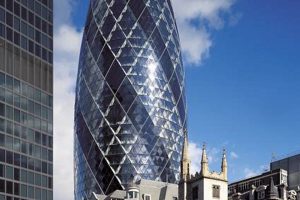A skyscraper, also known as a high-rise or a tower block, is a continuously habitable high-rise building that has over 40 floors and is taller than 150 meters (492 feet). Skyscrapers are often used for commercial purposes, such as offices, hotels, and retail stores. The world’s tallest skyscraper is the Burj Khalifa in Dubai, United Arab Emirates, which stands at 828 meters (2,717 feet) tall.
Skyscrapers offer a number of benefits over other types of buildings. They can accommodate a large number of people and businesses in a relatively small area, which can help to reduce traffic congestion and pollution. Skyscrapers can also be more energy-efficient than other types of buildings, as they can be designed to take advantage of natural light and ventilation. Additionally, skyscrapers can be iconic landmarks that can help to define a city’s skyline.
Skyscrapers have been built for centuries, but the first modern skyscraper was the Home Insurance Building in Chicago, which was completed in 1885. Since then, skyscrapers have been built all over the world, and they have become a symbol of urban development and economic prosperity.
1. Height
In the realm of skyscrapers, height reigns supreme as a defining characteristic. Buildings that soar above 150 meters, often reaching dizzying heights, are what set skyscrapers apart from other structures. This extraordinary elevation is not merely a matter of aesthetics; it is a testament to engineering prowess and a symbol of architectural ambition.
Height plays a pivotal role in determining what constitutes the biggest skyscraper. The taller a building, the more stories it can accommodate, and the greater the number of people and businesses it can house. Height also contributes to a skyscraper’s iconic status. A towering skyscraper becomes a landmark, a symbol of a city’s skyline and economic vitality.
The Burj Khalifa in Dubai, standing at an awe-inspiring 828 meters, exemplifies the significance of height in defining the biggest skyscraper. Its sheer height has made it not only the tallest building in the world but also a global icon. The Shanghai Tower in China and the Makkah Royal Clock Tower in Saudi Arabia are other notable examples of skyscrapers that have pushed the boundaries of height and redefined the concept of what is considered the biggest.
The pursuit of height in skyscrapers is not without its challenges. Engineering such colossal structures requires innovative solutions to overcome the immense weight and wind forces they face. However, the rewards of achieving extraordinary elevations are evident in the breathtaking views, efficient use of space, and the creation of architectural marvels that inspire and captivate.
Understanding the connection between height and the concept of “what is the biggest skyscraper” is essential for appreciating the architectural significance and engineering achievements of these extraordinary structures. Height is not merely a number; it is a testament to human ingenuity and the relentless drive to build upwards, shaping skylines and transforming our cities.
2. Floors
The number of floors in a skyscraper is a crucial factor in determining its size and overall stature. Buildings that consist of numerous levels, typically surpassing 40 stories, are considered skyscrapers. This vertical expansion serves several purposes and plays a significant role in understanding “what is the biggest skyscraper”.
Firstly, the number of floors directly impacts the height of a skyscraper. The more floors a building has, the taller it will be. Height is a defining characteristic of skyscrapers, and it contributes to their iconic status and visibility in a city’s skyline. Taller buildings can accommodate more people and businesses, increasing their potential for commercial success.
Secondly, the number of floors affects the functionality and efficiency of a skyscraper. Each floor can be designed for a specific purpose, such as office space, retail outlets, or residential units. This vertical zoning allows for efficient space utilization and caters to the diverse needs of tenants. Skyscrapers with numerous floors can house a wide range of activities within a single structure, creating a vibrant and self-contained urban environment.
Thirdly, the number of floors in a skyscraper is a testament to advanced engineering and construction techniques. Building upwards requires innovative solutions to overcome challenges such as structural stability, wind resistance, and efficient transportation of people and goods. Skyscrapers with numerous floors push the boundaries of architectural design and engineering capabilities, showcasing the latest advancements in the field.
In conclusion, the number of floors in a skyscraper is a key component in defining “what is the biggest skyscraper”. It influences the height, functionality, and engineering complexity of these architectural marvels. Understanding this connection provides insights into the design, construction, and practical significance of skyscrapers, highlighting their role in shaping urban landscapes and accommodating the needs of modern society.
3. Purpose
The purpose of a skyscraper, primarily designed for commercial use, plays a significant role in defining “what is the biggest skyscraper”. Commercial buildings are constructed to serve specific business needs and cater to various urban functions. Understanding this purpose provides valuable insights into the design, functionality, and economic implications of skyscrapers.
- Office Space: Skyscrapers are predominantly used for office space, housing businesses, corporations, and government agencies. The concentration of offices in skyscrapers creates efficient business districts, fosters collaboration, and supports economic growth.
- Hotels: Many skyscrapers incorporate luxury hotels, offering breathtaking views, convenient amenities, and proximity to business hubs. These hotels cater to business travelers, tourists, and special events, adding to the vibrancy of the urban environment.
- Retail Outlets: The lower levels of skyscrapers often house retail outlets, including shops, restaurants, and entertainment venues. This integration of commercial and retail space creates a dynamic urban experience, attracting shoppers, tourists, and residents alike.
- Mixed-Use Developments: Modern skyscrapers often adopt a mixed-use approach, combining commercial, residential, and retail spaces within a single structure. This integrated design optimizes space utilization, creates diverse urban environments, and fosters a sense of community.
The commercial purpose of skyscrapers shapes their design, amenities, and overall impact on the urban fabric. These buildings are designed to accommodate large numbers of workers, visitors, and customers, influencing traffic patterns, public transportation systems, and the overall economic vitality of the city.
4. Landmark
Skyscrapers, as the biggest and most prominent structures in a city’s skyline, often transcend their functional purpose and become iconic landmarks that define the cityscape. This iconic status is not merely a result of their height and size but also their architectural design and cultural significance.
The connection between “Landmark: Becoming iconic symbols that define cityscapes” and “what is the biggest skyscraper” is evident in several ways:
- Symbolism and Identity: Skyscrapers, as the tallest and most visible structures in a city, become symbols of urban power, economic prosperity, and cultural identity. They represent a city’s aspirations and serve as a source of pride for its residents.
- Tourism and Cultural Significance: Iconic skyscrapers attract tourists from around the world, eager to witness these architectural marvels firsthand. They become cultural landmarks, featured in movies, literature, and art, shaping the city’s global image.
- Economic Impact: Landmark skyscrapers can stimulate economic growth by attracting businesses, investments, and tourism. They create a positive perception of the city, enhancing its reputation as a desirable place to live, work, and invest.
- Urban Planning: The presence of iconic skyscrapers influences urban planning decisions. They serve as focal points for development, shaping the city’s growth patterns and transportation infrastructure.
Examples of iconic landmark skyscrapers include the Empire State Building and the Chrysler Building in New York City, the Petronas Towers in Kuala Lumpur, and the Burj Khalifa in Dubai. These structures have become synonymous with their respective cities, defining their skylines and serving as symbols of national pride.
Understanding the connection between “Landmark: Becoming iconic symbols that define cityscapes” and “what is the biggest skyscraper” provides valuable insights into the cultural, economic, and urban planning implications of these architectural marvels. Skyscrapers are not just buildings; they are symbols of progress, ambition, and the human desire to build upwards.
5. Engineering
In the realm of skyscrapers, engineering plays a pivotal role in determining “what is the biggest skyscraper”. Constructing these towering structures requires advanced techniques to withstand immense weight and the forces of nature, ensuring the safety and stability of occupants and the longevity of the building itself.
The weight of a skyscraper is a significant factor that must be carefully managed. As buildings rise higher, the weight of the materials used in construction, along with the weight of occupants and equipment, can become enormous. To counter this, engineers employ innovative structural systems, such as reinforced concrete cores and steel frameworks, which distribute the weight evenly and provide the necessary strength to support the building’s height.
Natural forces, such as wind and seismic activity, pose another set of challenges for skyscraper engineering. Wind can create lateral forces that sway the building, potentially causing structural damage or discomfort for occupants. Engineers use wind-resistant designs, such as aerodynamic shapes and tuned mass dampers, to mitigate these effects. In earthquake-prone areas, skyscrapers are equipped with seismic base isolation systems or reinforced structural elements to withstand the ground shaking.
The engineering prowess behind skyscrapers is evident in real-life examples. The Burj Khalifa, the world’s tallest building, employs a reinforced concrete core and a steel exterior frame to withstand its immense weight. The Taipei 101, known for its resistance to typhoons and earthquakes, utilizes a tuned mass damper to counteract wind-induced swaying. These engineering marvels demonstrate the ingenuity and technical expertise required to build the biggest skyscrapers.
Understanding the connection between engineering and the concept of “what is the biggest skyscraper” highlights the importance of structural integrity, safety, and resilience in skyscraper design. Engineering innovation allows architects and engineers to push the boundaries of height and create iconic structures that redefine skylines and contribute to the advancement of urban environments.
6. Sustainability
In the realm of skyscrapers, sustainability has emerged as a critical consideration in defining “what is the biggest skyscraper”. As these architectural marvels reach unprecedented heights, there is a growing emphasis on incorporating eco-friendly features to reduce their environmental impact and promote sustainable urban development.
- Energy Efficiency: Biggest skyscrapers consume vast amounts of energy for lighting, heating, cooling, and other operations. Sustainable skyscrapers employ energy-efficient lighting systems, insulation, and renewable energy sources, such as solar panels and wind turbines, to minimize their energy consumption and carbon footprint.
- Water Conservation: Water scarcity is a pressing issue in many urban areas. Sustainable skyscrapers implement rainwater harvesting systems, low-flow plumbing fixtures, and drought-tolerant landscaping to reduce water consumption and promote water conservation.
- Green Materials: The construction of skyscrapers involves the use ofof materials. Sustainable skyscrapers prioritize the use of recycled and sustainable materials, such as recycled steel and low-VOC (volatile organic compound) paints, to minimize their environmental impact.
- Waste Management: Skyscrapers generate significant amounts of waste during construction and operation. Sustainable skyscrapers implement waste management plans that emphasize waste reduction, recycling, and composting to divert waste from landfills and promote circularity.
Examples of sustainable skyscrapers include the Burj Khalifa, which features a double-skin facade that reduces heat gain and energy consumption, and the Shanghai Tower, which incorporates wind turbines and rainwater harvesting systems. These buildings demonstrate how sustainability can be seamlessly integrated into the design and construction of the biggest skyscrapers, contributing to a more sustainable and environmentally conscious urban environment.
7. Density
In exploring the connection between “Density: Accommodating a significant population within a limited footprint” and “what is the biggest skyscraper”, it becomes evident that density plays a crucial role in defining the scale and impact of these architectural marvels. Skyscrapers are designed to maximize v
ertical space utilization, allowing them to house a substantial number of people and businesses within a relatively small physical area.
This density is achieved through careful planning and innovative design. Skyscrapers employ efficient floor plans, shared common areas, and optimized building systems to accommodate a large population without compromising comfort or functionality. Vertical transportation systems, such as elevators and escalators, are essential in ensuring efficient movement of people throughout the building.
The importance of density in skyscrapers is multifaceted. Firstly, it allows for efficient land use in urban areas where space is often scarce. By building upwards, skyscrapers can reduce the need for urban sprawl and preserve valuable land for other purposes, such as parks, green spaces, and transportation infrastructure.
Secondly, density promotes sustainable urban development. Skyscrapers can concentrate a significant population in a single location, reducing the need for extensive commuting and promoting walkability and public transportation. This concentration also fosters a sense of community and creates vibrant urban environments.
Real-life examples of skyscrapers that embody the concept of density include the Burj Khalifa in Dubai, which houses over 30,000 people and numerous businesses within its 162 floors. Another notable example is the Shanghai Tower in China, which accommodates a mixed-use program of offices, retail, and residential units, serving a diverse population of over 10,000 people.
Understanding the connection between “Density: Accommodating a significant population within a limited footprint” and “what is the biggest skyscraper” is crucial for architects, urban planners, and policymakers. It highlights the importance of maximizing vertical space utilization to create sustainable and livable urban environments. As cities continue to grow, the ability to accommodate a growing population within limited land areas will be essential for the future of urban development.
8. History
Exploring the connection between “History: Tracing origins back centuries, with continuous advancements in design and construction” and “what is the biggest skyscraper” unveils a deep-rooted relationship that has shaped the evolution and significance of these architectural marvels. Understanding this historical context is paramount in comprehending the scale, complexity, and impact of modern skyscrapers.
The history of skyscrapers traces back to the late 19th century, with the Home Insurance Building in Chicago being widely recognized as the first skyscraper. This pioneering structure, standing at 10 stories, laid the foundation for advancements in design and engineering that would eventually lead to the construction of the tallest buildings in the world. Over the decades, architects and engineers pushed the boundaries of height and design, driven by technological innovations and a desire to create iconic landmarks.
The development of new materials, such as steel frames and reinforced concrete, played a transformative role in the evolution of skyscrapers. These materials provided the strength and stability necessary to construct buildings that reached unprecedented heights. Additionally, the invention of the elevator made it possible to efficiently transport people and goods to upper floors, further enabling the vertical growth of skyscrapers.
Historical skyscrapers have served as testbeds for innovative design and construction techniques that have shaped the industry. The Empire State Building, completed in 1931, showcased the use of setbacks to reduce wind resistance and create more usable floor space. The Sears Tower, completed in 1974, introduced the concept of a bundled tube structural system, which has become common in modern skyscraper design.
Understanding the historical context of skyscrapers is essential for appreciating the challenges and achievements associated with building these architectural marvels. The continuous advancements in design and construction have allowed architects and engineers to overcome technical obstacles and redefine the limits of what is possible. This historical journey has paved the way for the iconic skyscrapers that grace skylines around the world, serving as symbols of innovation, ambition, and urban progress.
9. Culture
The connection between “Culture: Reflecting societal aspirations, technological progress, and economic vitality” and “what is the biggest skyscraper” lies in the profound ways that skyscrapers embody and shape the cultural, technological, and economic landscape of a society.
- Symbolic Significance: Skyscrapers serve as iconic symbols of a city’s aspirations and achievements. Their towering heights and impressive designs reflect the ambition, drive, and optimism of the society that created them. For example, the Empire State Building in New York City has become an enduring symbol of American prosperity and technological prowess.
- Technological Innovation: The construction of the biggest skyscrapers pushes the boundaries of architectural and engineering innovation. They showcase the latest advancements in materials, structural systems, and construction techniques. The Burj Khalifa in Dubai, the world’s tallest building, is a testament to human ingenuity and the relentless pursuit of technological progress.
- Economic Drivers: Skyscrapers play a significant role in driving economic growth and prosperity. They house businesses, offices, and retail spaces, creating jobs and stimulating economic activity. The presence of major skyscrapers in a city often attracts investment, tourism, and global recognition, further boosting the local economy.
- Cultural Expression: Skyscrapers are often designed to reflect the cultural values and identity of a society. Their architectural styles, public spaces, and amenities are shaped by the local culture and aspirations. For instance, the Petronas Towers in Kuala Lumpur incorporate traditional Islamic motifs, showcasing the cultural heritage of Malaysia.
In conclusion, the biggest skyscrapers are not merely architectural feats; they are cultural icons, technological marvels, economic powerhouses, and expressions of societal values. They stand as testaments to the human desire to build upwards, innovate, and shape the future. Understanding the cultural, technological, and economic implications of skyscrapers is essential for comprehending their significance and impact on the societies they serve.
Frequently Asked Questions about “What is the Biggest Skyscraper”
This section addresses common questions and provides informative answers related to the topic of “what is the biggest skyscraper”.
Question 1: What is the definition of a skyscraper?
A skyscraper is a continuously habitable high-rise building that has over 40 floors and is taller than 150 meters (492 feet).
Question 2: What is the tallest skyscraper in the world?
The tallest skyscraper in the world is the Burj Khalifa in Dubai, United Arab Emirates, which stands at 828 meters (2,717 feet) tall.
Question 3: What factors determine the height of a skyscraper?
The height of a skyscraper is determined by several factors, including architectural design, engineering capabilities, construction materials, and local building regulations.
Question 4: What are the benefits of building skyscrapers?
Skyscrapers offer numerous benefits, such as efficient land use, reduced traffic congestion, increased energy efficiency, and iconic landmarks that enhance urban skylines.
Question 5: What are the challenges associated with building skyscrapers?
Building skyscrapers involves challenges such as structural stability, wind resistance, fire safety, and efficient transportation of people and materials.
Question 6: How do skyscrapers contribute to urban development?
Skyscrapers play a significant role in urban development by accommodating large populations, creating vibrant mixed-use spaces, and serving as symbols of economic prosperity and architectural innovation.
In summary, skyscrapers are marvels of modern architecture and engineering that push the boundaries of height and design. They offer numerous benefits and present unique challenges, while also contributing to the economic and cultural fabric of cities.
Proceed to the next section to explore more details and insights related to skyscrapers.
Understanding Skyscrapers
Skyscrapers, with their towering heights and architectural grandeur, offer a fascinating subject for exploration and study. Here are some tips to enhance your understanding of these architectural marvels:
Tip 1: Delve into Architectural Styles
Skyscrapers showcase a diverse range of architectural styles, from Art Deco to Modernism. Study the distinct characteristics of each style, such as ornamentation, setbacks, and window designs. This knowledge will deepen your appreciation for the aesthetic nuances of skyscrapers.
Tip 2: Discover Engineering Innovations
Skyscrapers are feats of engineering prowess. Research the structural systems, materials, and construction techniques employed to achieve their remarkable heights. Understand how engineers overcome challenges like wind resistance and seismic activity to ensure the safety and stability of these structures.
Tip 3: Explore Urban Planning Impacts
Skyscrapers have a significant impact on urban planning. Examine how their density affects land use, traffic patterns, and the creation of mixed-use spaces. Analyze the role of zoning regulations and sustainability considerations in shaping skyscraper developments.
Tip 4: Analyze Economic Significance
Skyscrapers serve as economic powerhouses. Investigate their role in attracting businesses, driving investment, and supporting job creation. Understand how skyscrapers contribute to the overall economic growth and prosperity of cities.
Tip 5: Appreciate Cultural Symbolism
Skyscrapers often become iconic symbols of cities and nations. Examine the cultural significance they hold, the values they represent, and the ways in which they reflect societal aspirations and technological advancements.
Summary:
By following these tips, you will gain a comprehensive understanding of skyscrapers. Explore their architectural styles, engineering innovations, urban planning impacts, economic significance, and cultural symbolism. This knowledge will enrich your appreciation for these architectural wonders and provide a deeper insight into their role in shaping our cities and society.
Conclusion
In exploring the concept of “what is the biggest skyscraper”, this article has examined various aspects that define and shape these architectural marvels. From their towering heights and engineering innovations to their urban planning impacts and cultural significance, skyscrapers represent a fascinating subject of study and appreciation.
As technology continues to advance and architectural boundaries are pushed further, the future of skyscrapers holds exciting possibilities. The pursuit of sustainability, the integration of smart technologies, and the quest for new heights will undoubtedly shape the next generation of these iconic structures. Understanding the past, present, and future of skyscrapers not only enriches our knowledge of architecture and engineering but also provides valuable insights into the evolution of our cities and societies.







